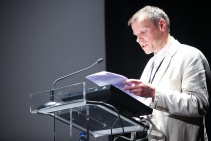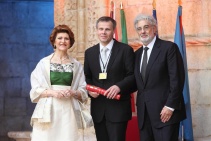Home » Gintaras Karosas' report delivered at the European Heritage Congress


Gintaras Karosas' report delivered at the European Heritage Congress
Situated on the outskirts of Vilnius, the Liubavas Manor is one of Lithuania's oldest manors, the historical record of which dates back to the 16th century. In the past five hundred years, the manor was in the possession of Lithuanian political and cultural elite. Among the owners of the manor was also the Lithuanian royal family, thought to have relished the savoury fish from the ponds of the Liubavas Manor. Later, the manor was passed on to the factual ruler of Lithuania, Mikalojus Radvila the "Red", the families of the Golejevskis, Tiškevičius, Krišpinas Kiršenšteinas, and Slizienis. In the 19th century, the Liubavas Manor became home to the famous Lithuanian sculptor Rapolas Slizienis.
The Soviet occupation that broke up the Lithuanian independence in mid-20th century relentlessly ruined anything reminiscent of our country's history and culture. Majority of Lithuanian manor estates were turned into Soviet collective farms and the last owner of the Liubavas Manor, Slizienis, fell victim to the Soviet persecution.
Milling is one of Lithuania's most important traditional economy branches. Barely several tens of water and wind mills that operated in the first half of the previous century remain to date. Majority of them are now abandoned and the technological equipment is missing. The Liubavas Manor watermill stopped working in the eighth decade of the last century and was left to fate with no maintenance. The watermill was on the verge of decay.
Liubavas Manor watermill is one of the most unique watermills in Lithuania. The watermill was constructed facing the pond on the Žalesa River by foreign craftsmen in 1902 to replace the former watermill.
The architecture of the watermill building is distinguishable for the quality of stone and brick masonry. Walls are made from cleaved or carved stone, the binding grout is invisible on the exterior of facade as the seams are filled with pebble inlay. The building is of a rectangular plan and looks like 1-storey construction from the pond side and like 2-storey construction from the yard side.
We have explored not only the watermill itself but also the history, architecture, art, and interwar residents of the Liubavas Manor. The watermill exhibition reveals the grand history of the manor. Schemes, descriptions, and an interactive terminal show the mill's equipment and technological processes, and promote the use of renewable energy sources.
Project results are presented in my book entitled Liubavas. Also, we have launched an internet website to introduce this technical heritage object to people around the world and, at the same time, share our experience. The website presents an attractive way of getting oneself acquainted with all the technological processes of the Liubavas Manor mill and its historical context.
With the input of our consistent efforts, the original Swedish-produced water turbine at the Liubavas watermill is spinning again. Restoration works focused not only on the building but also the technological equipment, including groat making, separation, cleaning, lifting, wood-cutting, turning, chip making and even electricity production facilities. Preservation and restoration was performed with the help of traditional craftsmen and our utmost care. We sought to employ traditional construction technology and material. Even the tiniest architectural elements were preserved.
Liubavas watermill can be considered exceptional in many aspects. Equipment of the water mill is painted. This is a rare exception among the Lithuanian watermills. Transmissions and some other equipment are factory-made. Engineering solutions are really remarkable.
I must admit that the restoration of the Liubavas mill and its consequent transformation into a museum was an entirely new experience to me. I am an artist, the founder of the open-air museum Europos Parkas, the author of its 55-hectare landscape, architecture and the multiple pieces of art that the park hosts. The Europos Parkas is located within a short distance from the Liubavas Manor mill, and some hundreds years ago, the current territory of Europos Parkas possibly belonged to the manor, too.
At the age of 19, I started creating Europos Parkas on the outskirts of Vilnius, an environment that reminded of Siberian forests. There were no roads, electricity, or telephone connection, and my first tools were an axe and a handheld saw. The idea of Europos Parkas represents the artistic conceptualisation of the European geographical centre in Lithuania through the creation of the space of a cultural polylogue - a meeting place for nature, art, and people from around the world.
The Museum of the Liubavas Manor Mill is the cultural heritage of our ancestors which we must preserve. We are creating Europos Parkas as a symbol of our present dedicated to the future generations.
I am very pleased to invite you all to come to Lithuania and visit the Liubavas Manor Watermill Museum and Europos Parkas.
Gintaras Karosas, Artist, Founder of Europos Parkas and Liubavas museums
2012 05 31
More about the European Heritage Awards Ceremony





